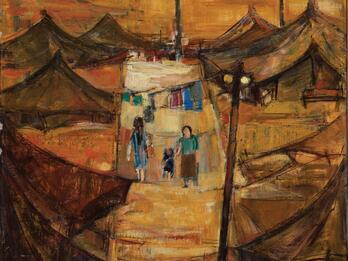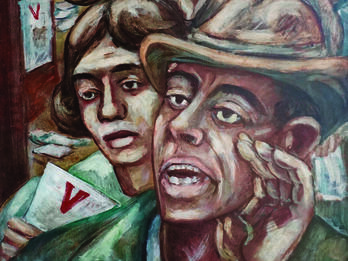Jewish Culture in the Postwar United States
American Jews entered a "golden age" of cultural expression and self-confidence after World War II, with declining antisemitism and increasing political and cultural representation.
In the very first issue of Commentary magazine, its editor Elliot E. Cohen optimistically predicted a bright future for American Jewry. The year was 1945, and the full shock of the disaster in Europe was just beginning to sink in. The great Jewish centers of Europe were gone, and it was still uncertain whether there would indeed be a Jewish state. But Cohen believed that American Jewry was fully prepared to shoulder its new burdens and assume leadership of the Jewish people. Commentary was an expression of faith in American Jewry.
During and after the Holocaust, American Jewry indeed entered what might be called a “golden age” of self-confidence and cultural expression. Novelists like Saul Bellow and Philip Roth came into their own, not as representatives of a parochial immigrant culture but as full-fledged American writers, entitled to a secure place in the literary pantheon. Jewish scholars and thinkers wrote with a new assertiveness and authority. After decades of discrimination, Jews finally entered American universities as teachers and as students. Far from being a marginal group in a Christian society, Jews claimed equal status with Catholics and Protestants. As Christian theologians took a new interest in Judaism, Jewish theological writing in turn flourished as never before. During these years, Jewish life writing confronted the pain of the past, yet it also underscored the redemptive promise of an open and tolerant society that could honor the legacy of the Jewish worlds that were no more.
The postwar rise of American Jewry had far-reaching consequences for the entire Jewish world. World War II brought about profound shifts in a community that had been grappling with antisemitism and discrimination. The impact of the Holocaust made antisemitism less acceptable, and American Jews as a group more determined to affirm their identity and defend fellow Jews around the world. The crowning of Bess Myerson as Miss America in 1945 seemed to symbolize that new era of acceptance. Hollywood abandoned its former reluctance to deal with Jewish issues: films like Crossfire and Gentleman’s Agreement harshly condemned antisemitism. Popular war novels like Norman Mailer’s The Naked and the Dead, Herman Wouk’s The Caine Mutiny, and Irwin Shaw’s The Young Lions depicted Jewish soldiers and officers who “belonged” in the military just as much as their non-Jewish comrades-in-arms did. Few Americans failed to hear the story of the four chaplains, including Rabbi Alexander Goode, who sacrificed their lives for others after the USS Dorchester was torpedoed in 1943.
While some observers doubted that American Jewry—with its low level of Jewish knowledge—could ever reach the creative heights of Spanish or Babylonian Jewry, Salo Baron, the foremost Jewish historian in the United States, expressed unbounded confidence. Jewish creativity, he insisted, could indeed flourish in an open society such as America’s. Another leading Jewish scholar, Gerson Cohen, also contended that America’s openness was “good for the Jews.” For many centuries, he observed, interchange with the gentile world had stimulated Jewish creativity.
Redefinitions of Jewish Identity in the Postwar United States
The year 1945 saw the first issue of Commentary magazine, which would become one of the most important journals in postwar Jewish America. In his introductory article, “An Act of Affirmation,” Commentary’s editor Elliot Cohen saw the establishment of this new journal as an “act of faith in our possibilities in America. . . . Surely, we who have survived catastrophe, can survive freedom, too.”
Commentary became an especially important forum for secular Jewish intellectuals who, in the aftermath of the Holocaust, began to evince an interest in Jewish matters. In one landmark article, a January 1949 response to Sartre’s “Anti-Semite and Jew,” critic Harold Rosenberg stressed that Jewish identity and Jewish memory were far more than just a reaction to antisemitism. Rosenberg defended the right of Jews to seek total assimilation if they so chose, an act that Sartre called inauthentic. But, he concluded, “Jewish identity has a remarkable richness for those who rediscover it within themselves.” Jews were free to fashion their own story and shape their Jewishness in any way they chose. Indeed, this new readiness to embrace, or at least to discern Jewishness in all its variety and indeterminacy, would play a major role in the cultural life of American Jewry in the three decades that followed the end of World War II.
In 1948, in “The Future of the American Jew,” Mordecai M. Kaplan, founder of Reconstructionist Judaism, had urged his readers to have faith in the “recuperative powers” of the Jewish people and Jews to adopt the prophet Ezekiel as their patron saint. Ezekiel, too, had confronted a people ravaged by national disaster, but he preached a message of self-confidence and revival.
This new Jewish assertiveness and optimism took many forms. As early as 1942, the philosopher Horace Kallen had unapologetically stressed that American Jews, far from being guests in America, were actually playing a critical role in the shaping of American society, whether in labor relations, civil rights, or the theater. What had been confined to the immigrant ghetto was now part and parcel of the American mainstream. “It was Hebraic mortar,” Kallen asserted, “that cemented the foundations of American democracy.” In the postwar years Kallen’s argument found new resonance as Jewish thinkers in various disciplines, eschewing any hint of prewar apologetics, proudly affirmed the importance of Jews for the West and for America.
Judaism and Higher Education in the Postwar United States
A spirit of hope for the future animated the opening of Brandeis University in June 1948. For the first time ever, American Jews were founding an American university and not a Jewish seminary, and this just one month after the establishment of a Jewish state. The new university, its supporters claimed, was a stirring symbol of Jewish resiliency. Its first president, Abram L. Sachar, called the new school “a corporate gift of Jews to American higher education.” His autobiography bore the telling title A Host at Last.
Admission quotas were slowly disappearing as the GI Bill gave many Jewish veterans a chance to attend college. Barriers to hiring Jewish faculty also gradually lowered, even as Jewish scholars became less diffident about expressing their Jewishness. As late as 1944, the eminent literary critic Lionel Trilling had declared in a symposium sponsored by the Contemporary Jewish Record (Commentary’s predecessor), “I do not think of myself as a Jewish writer. I do not have it in mind to serve by my writing any Jewish purpose.” But by 1950, in a Commentary essay entitled “Wordsworth and the Rabbis,” Trilling linked one his favorite poets with a Jewish text that he knew well, The Ethics of the Fathers (Pirkei Avot). There was a certain irony that Trilling, the first Jew to secure tenure in the Columbia University English department, would mention first-century rabbis in the same article as Wordsworth. The alleged inability of Jews to appreciate the subtleties of English literature had been a frequent pretext to deny them appointments. Now Trilling could write that “between the Law as the Rabbis understood it and Nature as Wordsworth understood it there is a pregnant similarity.”
Indeed, the postwar years saw a remarkable resurgence of Jewish scholarship in the United States and set the stage for the later establishment of Jewish studies programs in America’s finest universities and, in 1969, for the founding of the Association of Jewish Studies. This resurgence was due to many different factors: a decline in antisemitism, increasing interest in Jewish theology and history, a growing dialogue between Jewish and Christian scholars, the migration of many eminent Jewish scholars from Europe to the United States, and finally the postwar economic boom. In his 1950 article “The Challenge Facing Modern Jewish Scholarship,” Robert Gordis, one of the intellectual leaders of the Conservative movement, analyzed the achievements of the past and laid out an agenda for the future. He urged Jewish scholars to reject apologetics and reclaim biblical scholarship from often-biased Christian scholars.
Reframing the Jewish Past in the Postwar United States
Growing Jewish self-confidence also led to new efforts to fashion a usable past for American Jewry by ensuring that the memory of East European Jewry not be determined by comedians and crooners.
Max Weinreich, in his magnum opus, History of the Yiddish Language, and his son, Uriel Weinreich, in his call to create a cultural atlas of European Jewry, pointed the way to a usable past based on a distinct European Jewish civilization, Ashkenaz. Ashkenaz was rooted in the Yiddish language, in European space, and in a creative sense of time determined by textual study that led to constant dialogue between past and present. Ashkenaz had been no hermetic ghetto; its values could not only explain the past and but also guide American Jews in the future.
By the same token, literary critics like Irving Howe and Abraham Tabachnik called for a fresh reading of Yiddish culture as a locus not of shtetl piety but of revolutionary ferment and modernist creativity. Rabbi and philosopher Abraham Joshua Heschel, in The Eastern European Era in Jewish History, portrayed East European Jewry as a civilization defined by time and spirit rather than space. To remember that civilization was not only an act of piety but also a matter of urgent necessity, the survivors of that world had to transmit its legacy to American Jewry. “Solidarity with the past,” Heschel told an audience in January 1945, “must become an integral part of our existence. . . . [W]e still have the keys to the treasures. If we don’t recover them they’ll be lost forever.”



